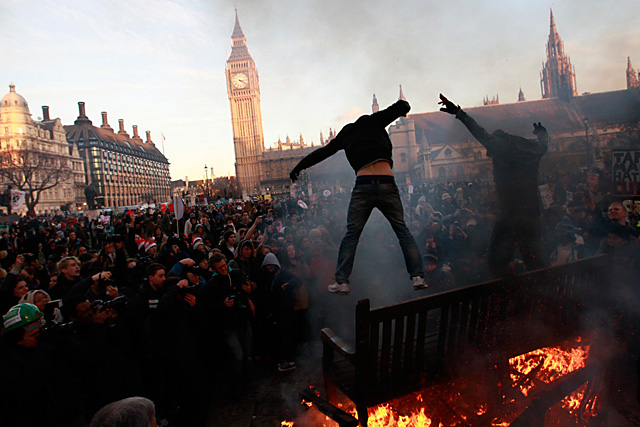These are the people the GOP refuses to tax
By Annie Gowen, Published: August 15
Millions of dollars worth of federal contracts transformed Anita Talwar from a government accounting clerk into a wealthy woman — one who can afford a $2.8 million home in the Washington suburbs with its own elevator, wine cellar and Swarovski crystal chandeliers.
Talwar, a 59-year-old immigrant from India, had no idea that she and her husband would amass a small fortune when she launched a company providing tech support to the federal government in 1987. But she shrewdly took advantage of programs for minority-owned small businesses and rode a boom in federal contracting.
By the time Talwar sold Advanced Management Technology in 2004, it had grown from a one-woman shop to a company with more than 350 employees and $100 million in annual revenue — all of it from government contracts.
Talwar’s success — and that of hundreds of other contractors like her — is a key factor driving the explosion of the Washington region’s wealth over the last two decades. It also has exacerbated the gap between high- and low-wage workers, which is wider in the D.C. area than almost anywhere else in the United States.
Washingtonians now enjoy the highest median household income of any metropolitan area in the country, and five of the top 10 jurisdictions in America — Loudoun, Howard and Fairfax counties, and Falls Church and Fairfax City — are here, census data shows.
The signs of that wealth are on display all over, from the string of luxury boutiques such as Gucci and Tory Burch opening at Tysons Galleria to the $15 cocktails served over artisanal ice at the W Hotel in the District to the ever-larger houses rising off River Road in Potomac.
But nowhere is the region’s wealth more concentrated than the place where Talwar purchased her 15,000-square-foot white-brick estate home: Great Falls, a once-rural enclave of about 15,000 residents 17 miles west of the White House.
Sixteen percent of Great Falls households earn $500,000 or above a year, and more than half make at least $250,000, according to Nielsen Claritas. By comparison, 11 percent of households in Potomac earn $500,000 or more, and McLean and Bethesda each boast 10 percent at that level.
Talwar’s neighbors are entrepreneurs, lobbyists, CEOs, tech moguls, financiers and defense contractors for whom two wars have been very, very good business. Their portfolios take hits when the stock market plummets, as it did this month, but the setbacks are usually temporary.
While others have struggled to recover from the recession, many of the residents of Great Falls have continued to launch new business ventures, enjoy easy access to venture capital and reap the benefits of bonuses and deferred compensation plans. Median household income there has increased 32 percent in the last 10 years, helping to widen the divide between those at the top and bottom of the economic ladder to a record high in Virginia.
Like their counterparts in California’s Silicon Valley or Seattle, Great Falls residents tend to be low-key about their wealth, more partial to sweatshirts than designer duds. In their jobs they wield enormous power, but it isn’t always obvious at first glance.
Look closely, however, and the patina of affluence is everywhere.
A white Mercedes sits next to a black Jaguar in the student parking lot at the local public high school, Langley High. At the community Easter egg roll, children grab eggs filled with chocolate and tiny gemstones like blue topaz and citrine.
The guest speaker for the new Rotary Club’s first meeting in June? Supreme Court Justice Antonin Scalia.
A surge in contracting
Forty years ago, few people thought of Washington as a place to get rich. It was a staid town where a third of the residents earned modest but steady paychecks working for the federal government.
The new Washington is a global business hub with thriving technology, biotech and communications industries. Only 12 percent of workers are federal employees. But the federal government remains an engine of job creation, outsourcing its tech support and other services to contracting firms ringing the Capital Beltway, a phenomenon that exploded in the years after 9/11.
More than $80 billion in federal contracting dollars will flow to the region this year, up from $4.2 billion in 1980, according to Stephen Fuller, director of the Center for Regional Analysis at George Mason University. Adjusted for inflation, that’s a seven-fold increase. A third of the region’s gross regional product now comes from federal spending.
But that tide is likely to slow because of a $1 trillion debt-reduction package approved earlier this month by Congress and President Obama. In the coming months, a bipartisan“supercommittee” will be searching for another $1.5 trillion in savings. Defense contractors are already bracing themselves for deep cuts in military spending.
Federal cash has been “the major catalyst for economic growth in the last 30 years,” said Rep. Gerald E. Connolly (D-Va.), former chairman of the board of supervisors in Fairfax County, where companies garner more federal contracting dollars than anywhere else in the country. “Clearly that [federal] presence and that pattern of investment has transformed the economy.”
The CEOs of big defense contractors here received compensation packages that rival those on Wall Street: Robert J. Stevens, chief executive of Lockheed Martin, received $19 million last year, while General Dynamics CEO Jay L. Johnson made $13 million, according to a recent survey conducted for The Washington Post by the research firm Equilar. The CEOs of smaller outfits also do well. Richard Montoni, the CEO of Maximus, pulls in $3 million.
Even rank-and-file employees benefit. In a recent survey by the jobs Web site ClearanceJobs.com, contractors with security clearances earned an average salary of $98,221, or 18 percent more than those doing similar jobs in the government.
The concentration of wealth in Washington has helped fuel public resentment of the federal government. “I think it reinforces the cultural disconnect that exists between Washington and the rest of the country,” said James Galbraith, a government professor at the University of Texas and director of its Inequality Project. “Do you have a community of insiders that has a hammerlock on their share of the public resources? I think the answer is yes.”
Meanwhile, the gap between the haves and the have-nots has grown dramatically wider, said Michael Cassidy, president of the Commonwealth Institute for Fiscal Analysis in Richmond.
High-wage workers in the District and Virginia make more than five times as much as their low-wage counterparts, the second- and third-highest such ratios in the country, a recent study by the institute showed. Only New Jersey had a greater gulf. Maryland ranked seventh.
Much of this inequity is driven by the fact that the region’s workforce is the best educated in the country, economists say. Many of the jobs both in and out of government require advanced or specialized degrees, which generally fetch hefty salaries.
Those in Virginia with college degrees saw their wages rise 5 percent during the recession, while those without saw steep declines, the study showed.
In Great Falls, Kimberley Sisco, 43, personifies the gap. She is just 18 credits shy of a degree in communications, law, economics and government from American University, but she works as a bartender.
She and her husband, who rent a stone cottage, are barely scraping by. “I’ve rolled quarters to pay the rent,” Sisco said. “I don’t go out to eat. I don’t take vacations. I haven’t shopped for new clothes, other than for my son, in seven years.”
Sisco used to consider herself solidly middle class. But when the economy tanked, her job as a graphic designer was outsourced to Indonesia, and her husband was unable find work as a handyman. Together, they brought in about $35,000 annually in the past two years.
She is keenly aware of the divide between herself and her neighbors. She built a backyard playground — with a tree house, slide and trampoline — entirely with neighbors’ gifts and castoffs. She sews blankets for abandoned fawns at the Wildlife Rescue League from donated mink coats.
When she e-mailed the local baseball league to ask if she could pay her son’s registration fee in installments, they waived it. She sent another e-mail and ended up with donated cleats and other practice gear.
She wonders if it would help her family’s future to finish her degree.
“I think about it all the time,” she said. “Can I do an independent study or get grants to help me with the cost? If you want to know the truth, I’m so tired most of the time, it’s enough just to get through each week right now.”
A transformation
In some ways, the wooded hills and rustic barns of Great Falls still hark back to the days when George Washington rode to the hounds nearby.
“When I moved out here, my parents thought I’d gone to the ends of the Earth,” said Wayne Foley, who has lived in Great Falls for more than three decades and runs a business that builds custom homes.
Back then, you could still buy a small house for less than $100,000. Now, the average home price is $1 million.
Foley has seen the place change from a community of farmers and horse-lovers into a haven for the wealthy, who have been tearing down old stone cottages and putting up increasingly large homes.
The first wave of money came in the ’90s, when AOL millionaires and other workers from the burgeoning tech corridor around Dulles began moving in. These days, many of Foley’s clients are defense contractors. He is doing one million-dollar remodeling project that includes an observatory, pistol range and audio-visual room.
It would be unfair to say that the recession had no impact here. Sixty-three homes went into foreclosure in the last four years, according to Hanley Wood Market Intelligence, a real estate research firm.
But longtime residents fear the area is becoming an insulated bubble where those who trim the shrubbery and pour the lattes at the coffee shop can’t afford to live. The number of children at Great Falls Elementary School eligible for free and reduced lunches — one measure of poverty — is less than 1 percent, compared to nearly a quarter of all Fairfax County schoolchildren.
“Twenty-five years ago, if you wanted to find someone to clean your house or a painter or a plumber, they were all local people,” said Karen Washburn, a local historian and real estate agent.
Now, on Saturday mornings, the parking lot in front of the Old Brogue Irish Pub is filled with luxury car aficionados at “Cars and Coffee,” a weekly event founded by local resident Bob Morris, who runs a string of successful golf courses.
Peter Garahan, who owns a Ferrari, a Bentley and an original Mini Cooper, said it’s a great place to schmooze and swap names of venture capitalists, references for potential employees and industry insights.
“It’s high-level networking,” said Garahan, 64, a tech entrepreneur. “It’s the glue that holds this community together.” And also helps perpetuate its wealth.
One recent day, Garahan stopped at the local sushi place to admire a blue Ford GTX convertible, one of only 30 such cars ever made, and ended up meeting its owner, Ian Landy. Landy, 47, is a swashbuckling Brit who races antique cars for fun and runs an experiential gift company called Excitations.
In an “only in Great Falls” type of moment, the two got to talking, and realized — surprise! — that they had both sold tech companies to Cisco in the late 1990s for more than $100 million.
Now the two are considering teaming up on a business deal.
A different economy
Anita Talwar was just 22 when she immigrated to the United States from New Delhi. Her first job was as an accounting clerk for the Army. She hadn’t been in the country long before she began thinking about striking out on her own.
Advanced Management Technology’s first big break came in 1992, when it secured a $3 million, three-year contract to provide help-desk support to the Federal Aviation Administration. Soon her firm was providing tech support services to a host of agencies, including the FAA, the Transportation Department and NASA. She eventually sold the company to an Arlington aviation consulting firm for an undisclosed sum.
Last year, with her two sons grown, Talwar and her husband, Madan, moved from Fairfax Station to their sprawling home in Great Falls. They were drawn by the country ambience and friends who lived nearby.
When asked if her neighbors had felt the impact of the recession, she smiled quietly and said she didn’t think so.
“I think the economy is very different in Washington, D.C., than in the rest of the country because of the federal dollars,” she said. “Directly or indirectly, we all work for the federal government.”
Staff researcher Magda Jean-Louis and research
















